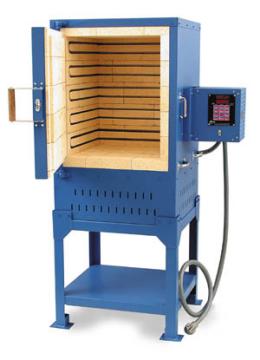 |
|
|
What Is A Kiln?An electric kiln is a heating chamber used to transform materials at high temperatures. A kiln hardens ceramic bodies using a process invented thousands of years ago. Clay, when heated properly, becomes hard enough to form tiles and vessels. Glazes fired over the clay become permanent decoration. Some of the most beautiful artwork in the world is made of clay. Porcelain from ancient China is priceless. Through the magic of heat, ordinary clay becomes strong enough to last many centuries, as history has proven. A kiln can fuse pieces of stained glass to form unique colors and patterns. Slump sheet glass into a mold to form bowls and vases. Bend glass strips over molds to form glass bracelets. Make glass earrings and pendants. As with ceramics, glass fusing is ancient. The Corning Glass Museum in Corning, New York owns fused glass bowls and pendants dating back to ancient Rome and Egypt. Kilns harden ceramic bodies, heat treat steel, melt glass into crucibles, fuse layers of stained glass, melt enameling powder onto copper jewelry, fire porcelain dolls, fuse clay silver—the applications are fascinating and endless. Paragon Industries has been a leader in the firing arts since 1948. We encourage you to come with us in exploring the world of high temperature. Why buy a Paragon? 1) Paragon uses heavy duty elements. We usually have more pounds of element wire per kiln than our competition. 2) Most of our top-loading kilns do not use element staples. The elements are seated in dropped, recessed grooves for better protection. Without staples, they are easier to change. 3) Some competitive kilns have one element groove per brick. We have two grooves per brick. This allows us to design the kiln with heavier gauge elements. 4) We use a barrel element connector that is simple to install and highly reliable. Please compare it with the element connectors of our competitors. The only tools needed for installation are Vice-Grips and a 1/4" nut driver. 5) Our newest ceramic instruction manual has 48 pages and contains 174 pictures. In addition, the ceramic kilns come with a separate manual for the digital controller or the Kiln Sitter, a controller trouble-shooter, an 8-page guide to firebricks, and a 4-page guide to installation. We are also developing a comprehensive series of video tapes, which appear on our website. 6) Most of our top-loading kilns are 2" deeper than our competitors' equivalent models. 7) Most of our top-loading kilns have a blank row of 2" high firebricks in the top of the kiln. The bricks that are most susceptible to damage in a top-loading kiln are the ones in the top of the walls. Since the 2" top bricks are blank (without an element groove), they are very durable and also easy to slide out to replace should they ever break. 8) Optional mercury relays are available in most digital models. These relays are extremely durable. 9) Most of our competitors use the Bartlett controller in their digital kilns. We use the Orton controller manufactured by the Orton Ceramic Foundation. It contains advanced features such as slow-cooling in Cone-Fire mode, pre-heat (to dry out greenware), 9 programs in Ramp-Hold mode, and optional 3-zone control. 10) Our kilns include a full-formed steel base to protect the firebrick bottom. The galvanized steel base has tabs that fold up inside the stainless steel jacket on all sides so that the entire brick bottom is covered and protected. 11) Many of our top-loading kilns have adjustable stainless steel jackets that can be tightened with a screwdriver. 12) Our switch boxes are easy to open. Most models have a box that hinges at the bottom. All the electrical components are within easy reach. 13) We use "tuned" elements in most top-loading kilns. This means the elements are designed to give more heat where it is needed. The top and bottom elements get hotter than the center elements, eliminating the need for 3-zone control. 14) Our spring counter-balance LiteLid is patented and has not been fully duplicated by our competitors. The unique feature of our lid support is that the lid "floats" during firing. This is to prevent the lid from rising in the front as the firebricks expand. |
 |
|
|

|
|
|
|
|
“Custom and standard Kilns and Industrial Furnaces for ceramics, pottery, heat treating, enameling, |
||||